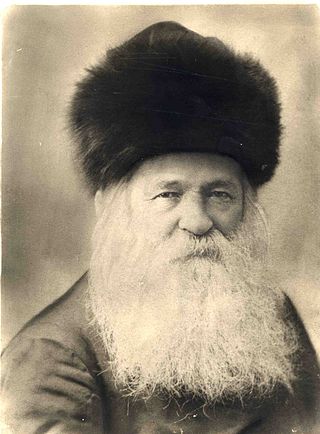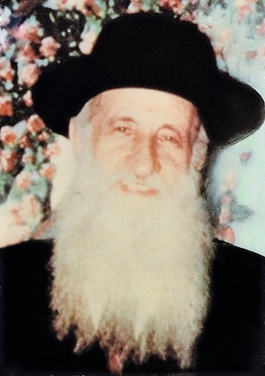Related Research Articles

Rabbinic literature, in its broadest sense, is the entire spectrum of rabbinic writings throughout Jewish history. However, the term often refers specifically to literature from the Talmudic era, as opposed to medieval and modern rabbinic writing, and thus corresponds with the Hebrew term Sifrut Chazal. This more specific sense of "Rabbinic literature"—referring to the Talmudim, Midrash, and related writings, but hardly ever to later texts—is how the term is generally intended when used in contemporary academic writing. The terms mefareshim and parshanim (commentaries/commentators) almost always refer to later, post-Talmudic writers of rabbinic glosses on Biblical and Talmudic texts.

The Sanhedrin was an assembly of either 23 or 71 elders, appointed to sit as a tribunal in every city in the ancient Land of Israel.

Yechiel Michel ha-Levi Epstein (24 January 1829 – 25 March 1908), often called "the Aruch haShulchan" after his magnum opus, Aruch HaShulchan, was a Rabbi and Posek in Lithuania.

Chaim Berlin was an Orthodox rabbi and chief rabbi of Moscow from 1865 to 1889. He was the eldest son of the Netziv, Rabbi Naftali Zvi Yehuda Berlin.
Saul Wahl Katzenellenbogen (1541–1617) was a wealthy and politically influential Polish Jew who is said to have briefly occupied the throne of Poland on 18 August 1587. He has historically borne the nickname, "Le roi d'un jour".

Chaim Ozer Grodzinski was a Av beis din, posek, and Talmudic scholar in Vilnius, Lithuania in the late 19th and early 20th centuries for over 55 years. He played an instrumental role in preserving Lithuanian yeshivas during the Communist era, and Polish and Russian yeshivas of Poland and during the Nazi invasion of Poland in 1939, when he arranged for these yeshivas to relocate to Lithuanian cities.
Samuel Judah Katzenellenbogen was an Italian Rabbi, the son of Rabbi Meir Katzenellenbogen.

Menachem Mendel Torem of Rimanov also known as Mendele Rimanover was a famous Hasidic Rebbe and one of the first five distributors of the Hasidic movement in Poland and Galicia together with Rabbi Yaakov Yitzchak of Lublin, Rabbi Yisrael Hopstein, Rabbi Avraham Yehoshua Heshel of Apta, and Rabbi Kalonymus Kalman Epstein.

Moetzes Gedolei HaTorah is the supreme rabbinical policy-making council of the Agudat Yisrael and Degel HaTorah movements in Israel; and of Agudath Israel of America in the United States. Members are usually prestigious Roshei Yeshiva or Hasidic rebbes, who are also usually regarded by many Haredi Jews to be the Gedolim ("great/est") sages of Torah Judaism. Before the Holocaust, it was the supreme authority for the World Agudath Israel in Europe.
Igud HaRabonim is a right-wing national rabbinical organization, with over 800 members across North America. Founded in 1942, it has for years received publicity from Rabbi Sholom Klass and The Jewish Press.

The Rapoport-Bick dynasty was the most important of all the non-chasidic rabbinic dynasties of Medzhybizh, in Ukraine. The Rapoport dynasty traces its roots back to Rabbi Jacob Emden (1697–1776) who was involved in the Frankist debates of 1757 and his father Rabbi Tsvi Hirsh Ashkenazi, known as the Chacham Tsvi (1660–1718). The Rapoports themselves are a long distinguished rabbinic family that traces its roots back to Central Europe and Northern Italy in the 15th century.

Pinchas Hirschprung was a Polish-Canadian rabbi, posek, and rosh yeshiva, who served as Chief Rabbi of Montreal from 1969 until his death.
Naftoli (Naphtalie) Carlebach (1916–2005) was an Orthodox Jewish rabbi and accountant.
In Jewish law, a posek is a legal scholar who determines the application of halakha, the Jewish religious laws derived from the written and Oral Torah in cases of Jewish law where previous authorities are inconclusive, or in those situations where no clear halakhic precedent exists.
The following outline is provided as an overview of and topical guide to Judaism:
Shlomo Hakohen Rabinowicz was the first Rebbe of the Radomsk Hasidic dynasty and one of the great Hasidic masters of 19th-century Poland. He is known as the Tiferes Shlomo after the title of his sefer, which is considered a classic in Hasidic literature.

Avraham Kalmanowitz was an Orthodox rabbi and rosh yeshiva (dean) of the Mir yeshiva in Brooklyn, New York from 1946 to 1964. Born in Russian empire, he served as rabbi of several Eastern European Jewish communities and escaped to the United States in 1940 following the German occupation of Poland. In the U.S. he was an activist for the rescue of the millions of Jews trapped in Nazi-ruled Europe and in the Soviet Union. He arranged the successful transfer of the entire Mir yeshiva from Lithuania to Shanghai, providing for its support for five years, and obtaining visas and travel fare to bring all 250 students and faculty to America after World War II. He established the U.S. branch of the Mir in 1946. In the 1950s he aided North African and Syrian Jewish youth suffering from persecution and pogroms, and successfully lobbied for the passage of a bill granting "endangered refugee status" to Jewish emigrants from Arab lands.

Abraham Hayyim Adadi was a Sephardi Hakham, dayan, av beit din, and senior rabbi of the 19th-century Jewish community of Tripoli, Libya. In his younger years, he lived in Safed, Palestine, and traveled to Jewish communities in the Middle East and North Africa as a shadar to raise funds for the Safed community. He returned to Safed a few years before his death and was buried there. He published several halakhic works and also recorded the local minhagim (customs) of Tripoli and Safed, providing a valuable resource for scholars and historians.

Sheea Halevy Herschorn was a Russian-born Canadian Jewish communal leader and posek, who served as Chief Rabbi of Montreal from 1951 until 1961.
References
- ↑ Ben Moshe, David (2008). The Secret of the Jews: Letters to Nietzsche. Gefen Publishing House. p. 24. ISBN 978-965-229-432-6.
- ↑ Solomon, David H. (1998). A History of my Family. D.H. Solomon. p. 58.
- 1 2 3 Rosenstein, Neil (1990). The Unbroken Chain: Biographical Sketches and the Genealogy of Illustrious Jewish Families from the 15th-20th century, Volume 1. CIS Publishers. p. 10. ISBN 978-0-9610578-4-8.
- ↑ Menton, Arthur F. (1996). Toledot Charlap. King David Press. p. 408. ISBN 9780965444101.
- 1 2 Goldwurm, Hersh (1989). The Early Acharonim: Biographical Sketches of the Prominent Early Rabbinic Sages and Leaders from the Fifteenth-Seventeenth Centuries. Mesorah Publications. p. 179. ISBN 978-0-89906-488-8.
- ↑ Landman, Isaac (1940). The Universal Jewish encyclopedia ...: An Authoritative and Popular Presentation of Jews and Judaism Since the Earliest Times, Volume 2. The Universal Jewish Encyclopedia. p. 525.
- ↑ "Hinda Halevi Katzenellenbogen". geni_family_tree. 1570. Retrieved 2023-08-10.